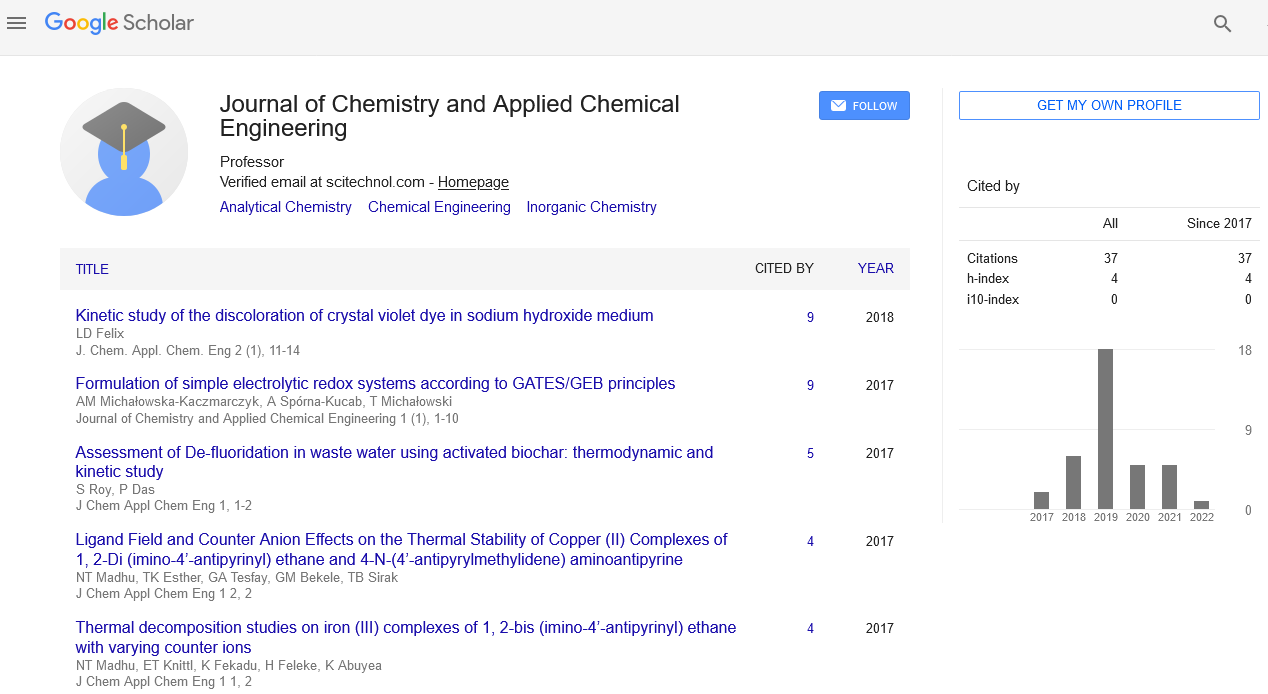Opinion Article, J Chem Appl Chem Eng Vol: 7 Issue: 2
The Palette of Chemical Information and Applications of Chemical Imaging
Katarina Beusch*
1Department of Medical Biochemistry, Karolinska Institute, Stockholm, Sweden
*Corresponding Author: Katarina Beusch,
Department of Medical Biochemistry,
Karolinska Institute, Stockholm, Sweden
E-mail: beuschkatarina@gmail.com
Received date: 23 May, 2023, Manuscript No. JCACE-23-106804;
Editor assigned date: 25 May, 2023, Pre QC No. JCACE-23-106804 (PQ);
Reviewed date: 08 June, 2023, QC No. JCACE-23-106804;
Revised date: 15 June, 2023, Manuscript No. JCACE-23-106804 (R);
Published date: 22 June, 2023, DOI: 10.4172/Jcace.1000024
Citation: Beusch K (2023) The Palette of Chemical Information and Applications of Chemical Imaging. J Chem Appl Chem Eng 7:2.
Description
Chemical imaging is a powerful analytical technique that combines traditional imaging methods with chemical analysis to visualize and map the distribution of chemical components within a sample. It provides valuable information about the spatial distribution of molecules, elements, and compounds, enabling researchers to gain insights into the composition and structure of various materials and biological specimens. Chemical imaging finds applications in diverse fields, including materials science, biology, medicine, environmental science, and forensic analysis.
Principles of chemical imaging
Chemical imaging involves the acquisition of spatially resolved spectroscopic data. It integrates spectroscopy, which provides chemical information, with imaging techniques that provide spatial information. By analyzing the interaction of light or other radiation with a sample, chemical imaging can identify and map various chemical species present within the sample.
Spectroscopic techniques in chemical imaging
Chemical imaging employs various spectroscopic techniques, each tailored to different types of samples and chemical information sought. Some common techniques include:
• IR imaging measures the absorption and emission of infrared light by molecules, providing information about chemical bonds and functional groups present in a sample.
• Raman imaging measures the inelastic scattering of light by molecules, yielding information about molecular vibrations and crystal structures.
• MSI combines mass spectrometry with spatial resolution to identify and quantify the distribution of different ions within a sample, providing information about the molecular composition of the sample.
• XRF imaging measures the characteristic X-ray emissions from elements in a sample, allowing the mapping of elemental distribution.
• NMR imaging uses the magnetic properties of atomic nuclei to create images and provide chemical information.
Imaging modalities
Chemical imaging can be performed using various imaging modalities, depending on the specific spectroscopic technique and the nature of the sample. Some common imaging modalities include:
Microscopy: Microscopy-based chemical imaging techniques, such as infrared microscopy and Raman microscopy, provide highresolution images of samples at the microscopic level.
Hyperspectral imaging: Hyperspectral imaging acquires a spectrum at each pixel of an image, generating a vast amount of spectral data that can be used to create chemical maps.
Multimodal imaging: Multimodal imaging combines multiple imaging techniques to provide complementary chemical information and a comprehensive view of a sample's composition.
Applications of chemical imaging
Chemical imaging finds diverse applications across various fields:
Materials science: In materials science, chemical imaging is used to study the composition and structure of materials, including semiconductors, polymers, and nanomaterials. It aids in quality control, defect analysis, and optimization of material properties.
Biology and medicine: In biology and medicine, chemical imaging is employed to study tissue and cellular composition, disease pathology, drug distribution, and pharmacokinetics. It has applications in cancer research, neurodegenerative disease studies, and drug development.
Environmental science: Chemical imaging is used to study pollutants, trace elements, and contaminants in environmental samples, providing valuable insights into pollution sources and environmental impacts.
Forensic analysis: In forensic analysis, chemical imaging helps identify substances, such as drugs and explosives, and assists in crime scene investigations.
Art conservation: Chemical imaging is utilized in art conservation to analyze pigments, study degradation processes, and authenticate artworks.
Challenges and future developments
Despite its tremendous potential, chemical imaging also faces challenges. Some of these include:
Sensitivity and resolution: Improving the sensitivity and spatial resolution of chemical imaging techniques remains a priority for enhancing analytical capabilities.
Data analysis and interpretation: The vast amount of data generated by chemical imaging requires sophisticated data analysis and interpretation techniques.
Sample preparation: Ensuring adequate sample preparation without altering the chemical composition is difficult for accurate chemical imaging results.
Chemical imaging is a versatile and invaluable technique that provides spatially resolved chemical information across various scientific disciplines. From studying material properties to advancing medical research, this powerful analytical tool continues to revolutionize the way it explore and understand the world around us.
As technology advances and techniques become more accessible, chemical imaging is poised to play an even more significant role in shaping scientific discoveries and innovations in the future.
 Spanish
Spanish  Chinese
Chinese  Russian
Russian  German
German  French
French  Japanese
Japanese  Portuguese
Portuguese  Hindi
Hindi 